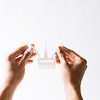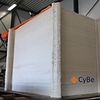Hey guys, it’s Logan from the FlexSolid workshop last night. I managed to test out the 2.85mm filament on the Ultimaker 2 at my school today twice, for small prints. I was very happy with what I saw! The parts came out incredibly flexible yet strong, and the shape retention after being pulled, smushed, crushed, bounced, etc was great! Our Ultimaker 2 has been having some extrusion issues for a while now, which caused the second print to be a bit on the poor side of quality, however the first one looked very good until I broke it! First I printed a hollow sphere of a 2cm diameter. I went a little bit over the top in testing how far I could crush it, and eventually split it open, since it was hollow and the two .4mm walls were the only thing to it. For that I used these settings:
Temp: 230C
Layer Height: .1mm
Build Plate: 60C
Speed: 20mm/s
Flow: 105%
Fan: On
Wall Thickness: .8mm
Wall Count: 2
Conclusion for this print: The print came out well, a few errors (due to the fact that I printed the sphere without any support or infil, so some bridging issues occurred, as expected. The part came out flexible, but less so than the second because of the thicker walls. Infil of 10-25% would have been beneficial as support for the top of the sphere, and to increase the strength of the part without sacrificing very much flexibility.
For my second print I made a small lidless box about 4 x 4 cm, with a height of almost 2 cm. The entire walls of the box were between 1.5 and 2mm thick (not referring to the print walls). Here are the settings I used for this:
Temp: 240C (originally at 230C however when I was having issues 10C increase helped significantly. Even though it was fine at 230C for the first print. I suspect it is related to the different extrusion rates due to speed and layer height.
Layer Height: .3mm
Build Plate: 60C
Speed: 30mm/s
Flow: 105%
Fan: On
Wall Thickness: .4mm
Wall Count: 2
Conclusion for this print: The print had issues, in part because I was tweaking settings during the entirety of the print, and in part because the U2 has extrusion problems with regular filament sometimes. This part came out much more flexible, and can be completely crumpled up with ease. This is due to the thinner, more regular thickness walls. It is also because of the poor extrusion that caused there to be gaps in the walls in some places and a lesser degree of consisent connection and adhesion. However I am very happy with the print because it better demonstrates the flexibility and shape retention of the material.
Overall Conclusion: FlexSolid looks like a great material I definitely will be using more of in the future! As for specific printing settings, here are my thoughts. 230C-240C seems to work the best, the higher temperature is necessary for lower resolution prints where the distance between the layers that are adhering is greater, and the slightly higher temperature helps compensate in adhering properly. Printing at 20mm/s seems to be the best call, and 30mm/s seemed too fast to me, with the nozzle bending the print small amounts on sharp turns, etc. .1mm print was more successful for me than .3mm, and I think that is because the filament really seems to work its best the lower the speed it is being extruded at. This characterist may just be for Bowden printers like the Ultimaker 2, since I do imagine it does grab the inside of the guide tube. For the best overall success and quality, the settings I used in the first print are what I would reccomend. I’m really enjoying this filament and hope to see more of it!
I will do my best to upload a few pictures in the next few days. I am in the middle of writing a paper at the moment, so right now I cannot. I hope these settings and thoughts help!


 Would you be willing to start a new thread about this print, so it doesn’t get lost in this one? And please share the source of the design file too. It’s already day 6, how is the strap holding up?
Would you be willing to start a new thread about this print, so it doesn’t get lost in this one? And please share the source of the design file too. It’s already day 6, how is the strap holding up?